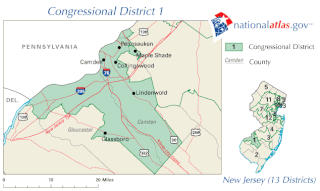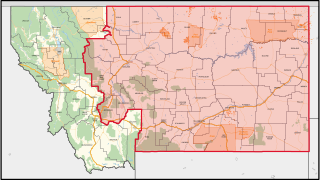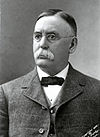
The 3rd United States Congress was a meeting of the legislative branch of the United States federal government, consisting of the United States Senate and the United States House of Representatives. It met at Congress Hall in Philadelphia, Pennsylvania from March 4, 1793, to March 4, 1795, during the fifth and sixth years of George Washington's presidency.

The 9th United States Congress was a meeting of the legislative branch of the United States federal government, consisting of the United States Senate and the United States House of Representatives. It met in Washington, D.C., from March 4, 1805, to March 4, 1807, during the fifth and sixth years of Thomas Jefferson's presidency. The apportionment of seats in the House of Representatives was based on the 1800 United States census. Both chambers had a Democratic-Republican majority.

North Dakota's at-large congressional district is the sole congressional district for the state of North Dakota. Based on size, it is the eighth largest congressional district in the nation.

From 1993 to 2023, Montana was represented in the United States House of Representatives by one at-large congressional district, among the 435 in the United States Congress. The district was the most populous U.S. congressional district, with just over 1 million constituents. It was also the second-largest by land area, after Alaska's at-large congressional district, and the largest by land area in the contiguous United States.
North Dakota's 1st congressional district is an obsolete congressional district in the state of North Dakota that existed from 1913 to 1933, and from 1963 to 1973.

New Jersey's 1st congressional district is a congressional district in the U.S. state of New Jersey. The district, which includes Camden and South Jersey suburbs of Philadelphia, has been represented by Democrat Donald Norcross since November 2014. It is among the most reliably Democratic districts in New Jersey, as it is mainly made up of Democratic-dominated Camden County.

Maryland's 5th congressional district comprises all of Charles, St. Mary's, and Calvert counties, as well as portions of Prince George's and Anne Arundel counties. The district is currently represented by Democrat Steny Hoyer, who from 2007 to 2011 and from 2019 to 2023 was House Majority Leader.
At different times in its history, Washington elected one or more U.S. representatives at-large statewide.
Illinois elected its United States Representative at-Large on a general ticket upon achieving statehood December 3, 1818. It last elected a US Representative in the Election of 1946. The district has been inactive since.
Michigan's at-large congressional district may refer to a few different occasions when a statewide at-large district was used for elections to the United States House of Representatives from Michigan.
During the first twenty-four Congresses, Connecticut elected all its representatives in Congress from a single multi-member Connecticut at-large congressional district.
Massachusetts's at-large congressional seat is an obsolete construct only used during the 1792–1793 United States House of Representatives elections in Massachusetts. In that election, one of the state's then-14 representatives to the U.S. House was elected statewide at-large. At that time, the U.S. state of Massachusetts included the District of Maine.

Montana's 1st congressional district is a congressional district in the United States House of Representatives that was apportioned after the 2020 United States census. The first candidates ran in the 2022 elections for a seat in the 118th United States Congress.
Oregon's at-large congressional district is a former United States congressional district. During its existence, Oregon voters elected a Representative of the United States House of Representatives at-large from the entire state.
Alabama's 8th congressional district, now obsolete, was established in 1877.
Florida's at-large congressional district may refer to a few different occasions when a statewide at-large district was used for elections to the United States House of Representatives from Florida. The district is obsolete.
On three occasions in New York history, some members of the United States House of Representatives were elected statewide at-large. This was due to an increase of the number of representatives after the previous federal census, and the failure of the State Legislature to re-apportion the congressional districts in time for the next election.
South Carolina was readmitted to Congress in 1868, after passage of the 14th Amendment. That amendment ended the three-fifths rule effectively raising the population of states that once had slavery. As a result, South Carolina and other slave states tried to seat extra members of Congress. South Carolina choose two additional congress members during an at-large election in 1870. In one of those, Johann Peter Martin Epping defeated Lucius W. Wimbush by 61 votes: 71803-71742. But the House refused to seat him and the other at-large winner. "A number of southern states upon readmission claimed that since their slaves were emancipated, they were entitled to larger delegations in the House. Epping's election falls in this category. The claims were rejected by the House."

Montana's second congressional district is a congressional district in the United States House of Representatives that was apportioned after the 2020 United States census. The first candidates ran in the 2022 elections for a seat in the 118th United States Congress.
Oklahoma's 7th congressional district was a district that existed from 1915 through 1953, covering the southwestern portion of the state.
















